After reaching one dream, you don’t anticipate getting close to another in less than twenty-four hours. But in the jungle, the mighty jungle of Chitwan, things happen.
Through my travel guide, Jim Williams, and Dan, our private Chitwan guide (a Nepali who has visited J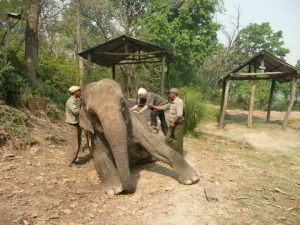 ackson Hole, Wyo.), an arrangement was made for me to ride an elephant bareback. No saddle. No box. Only in the elephant compound. So during the quiet time between early morning safari and lunch, I went to the elephant corral and there was an elephant willing to give me the thrill of riding her. Guests are not allowed to have such contact with the elephants, so I felt extremely honored. Most of the caretakers (each elephant has three caretakers exclusive to her/him) sat on the porch of their quarters to watch this old American lady who had to take a ride like they ride. I probably didn’t qualify in their eyes – although I have ridden horses most of my life, and have ridden camels, donkeys, dolphins, and hope to ride a yak. When I was an intern reporter at the Commercial Appeal, I rode an elephant in the parade from the train to the circus tent, and once in South Africa, in one of those controlled situations in a ring, on a ride, really for children, I took the opportunity to ride an African elephant. But this was going to be special, if I could get on her. No matter how thin or fat I have been, I could never get on a horse without pulling the saddle off. So I worried about how I was going to climb on an elephant.
ackson Hole, Wyo.), an arrangement was made for me to ride an elephant bareback. No saddle. No box. Only in the elephant compound. So during the quiet time between early morning safari and lunch, I went to the elephant corral and there was an elephant willing to give me the thrill of riding her. Guests are not allowed to have such contact with the elephants, so I felt extremely honored. Most of the caretakers (each elephant has three caretakers exclusive to her/him) sat on the porch of their quarters to watch this old American lady who had to take a ride like they ride. I probably didn’t qualify in their eyes – although I have ridden horses most of my life, and have ridden camels, donkeys, dolphins, and hope to ride a yak. When I was an intern reporter at the Commercial Appeal, I rode an elephant in the parade from the train to the circus tent, and once in South Africa, in one of those controlled situations in a ring, on a ride, really for children, I took the opportunity to ride an African elephant. But this was going to be special, if I could get on her. No matter how thin or fat I have been, I could never get on a horse without pulling the saddle off. So I worried about how I was going to climb on an elephant. 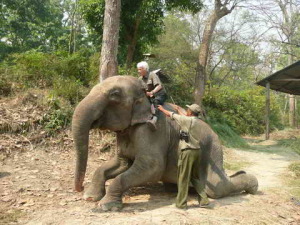
 ackson Hole, Wyo.), an arrangement was made for me to ride an elephant bareback. No saddle. No box. Only in the elephant compound. So during the quiet time between early morning safari and lunch, I went to the elephant corral and there was an elephant willing to give me the thrill of riding her. Guests are not allowed to have such contact with the elephants, so I felt extremely honored. Most of the caretakers (each elephant has three caretakers exclusive to her/him) sat on the porch of their quarters to watch this old American lady who had to take a ride like they ride. I probably didn’t qualify in their eyes – although I have ridden horses most of my life, and have ridden camels, donkeys, dolphins, and hope to ride a yak. When I was an intern reporter at the Commercial Appeal, I rode an elephant in the parade from the train to the circus tent, and once in South Africa, in one of those controlled situations in a ring, on a ride, really for children, I took the opportunity to ride an African elephant. But this was going to be special, if I could get on her. No matter how thin or fat I have been, I could never get on a horse without pulling the saddle off. So I worried about how I was going to climb on an elephant.
ackson Hole, Wyo.), an arrangement was made for me to ride an elephant bareback. No saddle. No box. Only in the elephant compound. So during the quiet time between early morning safari and lunch, I went to the elephant corral and there was an elephant willing to give me the thrill of riding her. Guests are not allowed to have such contact with the elephants, so I felt extremely honored. Most of the caretakers (each elephant has three caretakers exclusive to her/him) sat on the porch of their quarters to watch this old American lady who had to take a ride like they ride. I probably didn’t qualify in their eyes – although I have ridden horses most of my life, and have ridden camels, donkeys, dolphins, and hope to ride a yak. When I was an intern reporter at the Commercial Appeal, I rode an elephant in the parade from the train to the circus tent, and once in South Africa, in one of those controlled situations in a ring, on a ride, really for children, I took the opportunity to ride an African elephant. But this was going to be special, if I could get on her. No matter how thin or fat I have been, I could never get on a horse without pulling the saddle off. So I worried about how I was going to climb on an elephant. 
Sita Kali was brought from under her canopy and looked me in the eye. I looked her in the eye and asked permission silently. Then she kneeled down and stuck out her back left leg. Her trainer said for me to step on her leg and crawl up her back. I worried my 145 pounds might hurt her leg, but then remembered, this is an elephant. I had nothing to hold on to but depended on balance and stepped up until I could sit and put my legs around her neck. Two helpers held m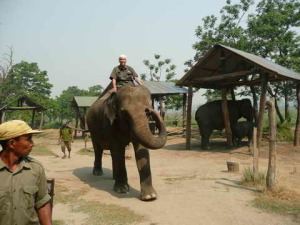 y arms so I wouldn’t fall backwards. Her skin was so dry, not slippery at all, and very wrinkled. That gave security. I scooted up to her ears, but I was encouraged to pull up more, pull up more and that was difficult since we were at an incline. Finally I got in the forward slot and found myself in a comfortable place high up off the ground and in a beautiful scene.
y arms so I wouldn’t fall backwards. Her skin was so dry, not slippery at all, and very wrinkled. That gave security. I scooted up to her ears, but I was encouraged to pull up more, pull up more and that was difficult since we were at an incline. Finally I got in the forward slot and found myself in a comfortable place high up off the ground and in a beautiful scene.
 y arms so I wouldn’t fall backwards. Her skin was so dry, not slippery at all, and very wrinkled. That gave security. I scooted up to her ears, but I was encouraged to pull up more, pull up more and that was difficult since we were at an incline. Finally I got in the forward slot and found myself in a comfortable place high up off the ground and in a beautiful scene.
y arms so I wouldn’t fall backwards. Her skin was so dry, not slippery at all, and very wrinkled. That gave security. I scooted up to her ears, but I was encouraged to pull up more, pull up more and that was difficult since we were at an incline. Finally I got in the forward slot and found myself in a comfortable place high up off the ground and in a beautiful scene. Then Sita rose up slowly off her knees . My right foot was caught in the chain around her neck. That was taken care of. I started to grab the chain. One helper said, “Grab both ears at the forward curl.” (Indian elephant ears have a curl along the top edge.). Sita began to flap her ears. I grabbed her ears. It was quite a bend over. Now kick her behind her ears. I was reluctant, as I didn’t want to hurt her. I had on hiking shoes, and normally her drivers are barefooted. I learned in an elephant lecture yesterday that if you kick both feet at the same time, that meant go forward. If you want to go right, kick behind the left ear, or go left, kick behind the right ear, sort of like reining polo ponies. I gently tapped her while the trainers grunted and yelled things I didn’t understand. Finally I got the courage to sit up straight and not hold on to anything, imagining myself was one of those circus girls in beaded costumes with their arms in the air, moving their bellies with the motion of the elephant. Move your hips, one man adv ised. So I had to relax and go with the flow. It was such a smooth thing, better than a camel, just sensational as we walked, though slowly, to the end of the road as I wished my grandchildren were riding with me. Sita was one good lady who knew she had a novice aboard.
ised. So I had to relax and go with the flow. It was such a smooth thing, better than a camel, just sensational as we walked, though slowly, to the end of the road as I wished my grandchildren were riding with me. Sita was one good lady who knew she had a novice aboard.
 ised. So I had to relax and go with the flow. It was such a smooth thing, better than a camel, just sensational as we walked, though slowly, to the end of the road as I wished my grandchildren were riding with me. Sita was one good lady who knew she had a novice aboard.
ised. So I had to relax and go with the flow. It was such a smooth thing, better than a camel, just sensational as we walked, though slowly, to the end of the road as I wished my grandchildren were riding with me. Sita was one good lady who knew she had a novice aboard. My safari ended. She knelt down low enough so I could throw my left leg over her back, get on my stomach and slide off, like getting off a horse. I was so thrilled I was trembling. And speechless.
So I applauded. Namaste. God bless Sita.
So I applauded. Namaste. God bless Sita.
It’s not uncommon to get addicted to elephants. They are creatures of habit with a life span about that of a human. They are extraordinary mothers. They protect their caretakers, to are willing to wake in the night, if they hear the right trumpet, to bring them water or anoth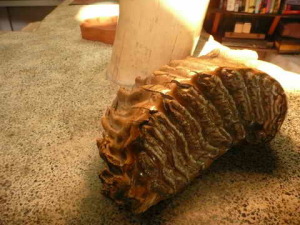 er elephant sandwich. Their trunks are amazing tools – they often stick it in their throats to suck out water and then spray it over their backs or sides to cool off. If a tourist drops a lens cap or a pencil in the path, the elephant smells it and picks it up. They have poor eyesight, but depend on sight and smell and sound for accuracy. Amazing creatures who have to spend 22 months carrying their babies. Imagine that, mothers.
er elephant sandwich. Their trunks are amazing tools – they often stick it in their throats to suck out water and then spray it over their backs or sides to cool off. If a tourist drops a lens cap or a pencil in the path, the elephant smells it and picks it up. They have poor eyesight, but depend on sight and smell and sound for accuracy. Amazing creatures who have to spend 22 months carrying their babies. Imagine that, mothers.
 er elephant sandwich. Their trunks are amazing tools – they often stick it in their throats to suck out water and then spray it over their backs or sides to cool off. If a tourist drops a lens cap or a pencil in the path, the elephant smells it and picks it up. They have poor eyesight, but depend on sight and smell and sound for accuracy. Amazing creatures who have to spend 22 months carrying their babies. Imagine that, mothers.
er elephant sandwich. Their trunks are amazing tools – they often stick it in their throats to suck out water and then spray it over their backs or sides to cool off. If a tourist drops a lens cap or a pencil in the path, the elephant smells it and picks it up. They have poor eyesight, but depend on sight and smell and sound for accuracy. Amazing creatures who have to spend 22 months carrying their babies. Imagine that, mothers. Sundai Kali, the feisty small elephant who loves hunting tigers, became my regular safari elephant. Twice more I climbed into the saddle, holding on for dear life to the bars of the open box, and was taken into the brush, reeds, mud and rivers looking for tracks of tigers. We actually found a Gaur, another word for buffalo, which is vicious as Cape buffalo’s in Africa. He downed his head and grunted fightin’ words, to which Sundai lifted her trunk and shreaked a loud get out of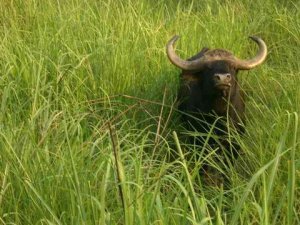 my way. It was funny. I snapped a quick photo and we left. Sundai did not like this beast. We saw the rare Marsh Mugger crocodile hidden in aq pond covered in green river lettuce and plenty of Asian one-horned rhinoceros. Flying peacocks, magpie robins, herons, storks, babblers, every kind of bird imaginable hung on the talk stalks of grass, in the trees, or on old stumps. Their music followed us everywhere. We saw evidence of an old tiger familiar to the area, but no tiger himself. It is so easy for them to hide and disappear into the swamps. So we were looking for the proverbial needle in a haystack.
my way. It was funny. I snapped a quick photo and we left. Sundai did not like this beast. We saw the rare Marsh Mugger crocodile hidden in aq pond covered in green river lettuce and plenty of Asian one-horned rhinoceros. Flying peacocks, magpie robins, herons, storks, babblers, every kind of bird imaginable hung on the talk stalks of grass, in the trees, or on old stumps. Their music followed us everywhere. We saw evidence of an old tiger familiar to the area, but no tiger himself. It is so easy for them to hide and disappear into the swamps. So we were looking for the proverbial needle in a haystack.
 my way. It was funny. I snapped a quick photo and we left. Sundai did not like this beast. We saw the rare Marsh Mugger crocodile hidden in aq pond covered in green river lettuce and plenty of Asian one-horned rhinoceros. Flying peacocks, magpie robins, herons, storks, babblers, every kind of bird imaginable hung on the talk stalks of grass, in the trees, or on old stumps. Their music followed us everywhere. We saw evidence of an old tiger familiar to the area, but no tiger himself. It is so easy for them to hide and disappear into the swamps. So we were looking for the proverbial needle in a haystack.
my way. It was funny. I snapped a quick photo and we left. Sundai did not like this beast. We saw the rare Marsh Mugger crocodile hidden in aq pond covered in green river lettuce and plenty of Asian one-horned rhinoceros. Flying peacocks, magpie robins, herons, storks, babblers, every kind of bird imaginable hung on the talk stalks of grass, in the trees, or on old stumps. Their music followed us everywhere. We saw evidence of an old tiger familiar to the area, but no tiger himself. It is so easy for them to hide and disappear into the swamps. So we were looking for the proverbial needle in a haystack. A combined landrover and boat trip down the river held excitement as we encountered the wild roving elephant in musk and had to take a different pathway. In the quietness of the canoe trip down Nariani River, we saw the very rare gharial crocodile, only his bottleneck mouth 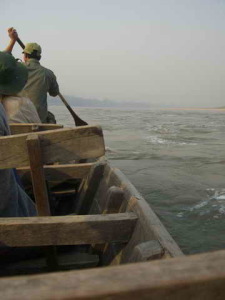 and eyes peeping above the river. But they are skiddish, so we passed on by. Back on shore, we passed groves of langur monkeys in huge Dadrungo trees rich with an orange berry that when eaten in abundance makes man or animal drunk.
and eyes peeping above the river. But they are skiddish, so we passed on by. Back on shore, we passed groves of langur monkeys in huge Dadrungo trees rich with an orange berry that when eaten in abundance makes man or animal drunk.
 and eyes peeping above the river. But they are skiddish, so we passed on by. Back on shore, we passed groves of langur monkeys in huge Dadrungo trees rich with an orange berry that when eaten in abundance makes man or animal drunk.
and eyes peeping above the river. But they are skiddish, so we passed on by. Back on shore, we passed groves of langur monkeys in huge Dadrungo trees rich with an orange berry that when eaten in abundance makes man or animal drunk. We leave this enthralling place at noon to fly out of an airport that is a mere cut field marked with white stones. Reminds me of days of East Africa in the ‘60ties. Right now I am listening to th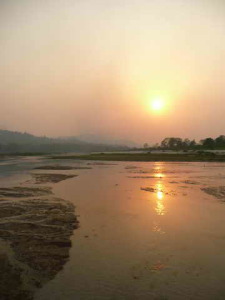 e yells of the rogue elephant trying to break into our camp trying to mate with one of the females. He roams up and down in front of the camp lifting his trunk and yelling every kind of curse, I guess. The one male in our camp is behind a fence tossing his huge tusks as a come on. If the two came together, there’d be a fight to the death. I hope the rogue gets happy soon.
e yells of the rogue elephant trying to break into our camp trying to mate with one of the females. He roams up and down in front of the camp lifting his trunk and yelling every kind of curse, I guess. The one male in our camp is behind a fence tossing his huge tusks as a come on. If the two came together, there’d be a fight to the death. I hope the rogue gets happy soon.
 e yells of the rogue elephant trying to break into our camp trying to mate with one of the females. He roams up and down in front of the camp lifting his trunk and yelling every kind of curse, I guess. The one male in our camp is behind a fence tossing his huge tusks as a come on. If the two came together, there’d be a fight to the death. I hope the rogue gets happy soon.
e yells of the rogue elephant trying to break into our camp trying to mate with one of the females. He roams up and down in front of the camp lifting his trunk and yelling every kind of curse, I guess. The one male in our camp is behind a fence tossing his huge tusks as a come on. If the two came together, there’d be a fight to the death. I hope the rogue gets happy soon. We return to Kathmandu for three nights to make preparations for the main aim of this trip, trekking to the base camp of Mt. Everest which begins Thursday. Say many prayers, please.
Photos: Getting up; Half way; the happiest camper; getting down; An elephant molar, 30 pounds; Gaur bull; riding the river in a canoe; the smokey sunrise at Chitwan.

Cousin Audrey, how exciting to run into Mary the other night and learn about your trip. I have printed your blog and sent it to Momma so she can read it as well. I hope your trip continues to be enjoyable. It sound like so much fun! Estie Woodall Harris
Thanks Audrey for sharing. You are an inspiration to me and my desire to eco-travel. Your writing makes me feel like I’m there. Thanks again. Christie Taylor (95.7 Hallelujah FM Radio Personality – Memphis)
Namaste,I am Reshmi from Tiger tops Jungle lodge.Now I am back in the Kathmandu because Tiger Tops is closed for monsoon.I will go back in September.Did you remember that you gave me two colourful bands for Sita kali and sunder kali.It’s on their hauda now.
Thank you very much for your help to ITNC.It’s nice to see Tiger Tops on your Blog.
Regards,
Reshmi
(reshmi@tigermountain.com)
PS:Wild elephant is still around and he took away one of our female elephant for 9 days.